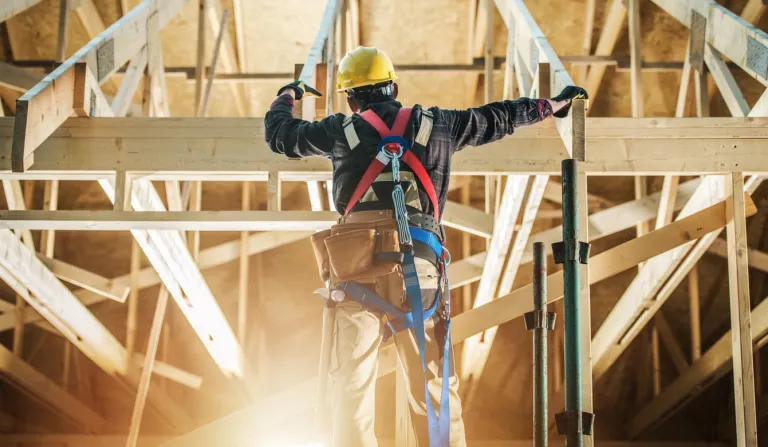Searching for the perfect home can be overwhelming—especially when nothing on the market fits your vision. That’s why many buyers choose to build from the ground up. Just like traditional home purchases, financing options like construction loans can help cover building costs.
Before starting the process, it’s essential to understand how construction loans work. This knowledge empowers future homeowners to secure land, fund their project, and bring their dream home to life.
Before You Begin

Building a home comes with key considerations. Beyond construction costs, the timeline can impact whether building is the right choice over buying.
Also, factor in ongoing expenses. While new homes typically need no immediate renovations, homeowners must budget for regular maintenance and homeowners insurance.
Read More: Home Equity Loan Explained: How It Works and Why It Matters
Step 1: Set a Realistic Budget for Your Home Build
Unlike buying an existing home, building a new one involves several cost factors beyond the house itself. Your budget should account for:
- Land purchase (if not already owned)
- Construction and labor costs
- Zoning, permitting, and inspection fees
If you don’t already own land, explore land and construction loans that bundle the lot purchase with building costs. Taking time to outline all expenses upfront helps you plan smarter and avoid budget surprises later.
Step 2: Review Your Credit Score and Down Payment Savings
Once you’ve set a budget, evaluate your financial readiness. Start by checking your credit score—higher scores typically lead to better loan terms, including lower construction loan interest rates. While minimum credit requirements vary by lender, improving your score before applying can increase your chances of approval and reduce borrowing costs.
Next, assess your down payment. Construction loans usually require larger down payments than traditional mortgages, often 20% or more. This is due to the higher risk for lenders, especially before a home is built. Make sure your savings can meet these requirements to move forward with financing confidently.
Step 3: Select a Licensed, Lender-Approved Home Builder
While building a home yourself may sound appealing, most lenders require working with a licensed, qualified builder to approve construction financing. Many even maintain a list of approved builders to ensure your project meets quality and timeline standards.
Choosing a lender-approved builder not only helps with loan approval but also protects your investment. These professionals typically have a solid history of delivering homes on time and within budget. If your lender doesn’t provide a list, be sure to vet builders carefully—look for strong reputations, proper licensing, and proven reliability.
Step 4: Explore a Construction-to-Permanent Loan for Simpler Financing
A construction-to-permanent loan streamlines the financing process by combining construction funding and your long-term mortgage into one loan. Instead of paying off a construction-only loan and applying for a separate mortgage, you transition seamlessly once the build is complete—typically with interest-only payments during construction.
This option helps avoid double closing costs and reduces the stress of securing a second loan. While rates may be slightly higher, many homeowners find the convenience and stability well worth it, especially during the often hectic building process.
Step 5: Consider a Construction-Only Loan for More Mortgage Flexibility
A construction-only loan finances the build phase—covering labor, materials, permits, and related costs—typically with a 12- to 18-month term. Once construction ends, the full balance is due, and most borrowers apply for a traditional mortgage at that point.
While this option requires paying two sets of closing costs, it offers the freedom to shop for the best mortgage terms after the home is completed. If your credit improves during construction, you may qualify for better interest rates than you would have at the start, potentially saving thousands over time.

Step 6: Consider a Renovation Loan as a Cost-Effective Alternative
If building from scratch exceeds your budget, a renovation loan could be a smart option. These loans allow you to purchase and upgrade an existing home under one loan—often at a lower cost than new construction. They’re ideal for buyers who can’t find their dream home on the market but are open to customizing an existing property.
Government-backed programs like FHA 203(k) or USDA renovation loans can simplify the process. Renovation loans also appeal to investors by combining property and renovation costs into a single loan, streamlining financing for flips or rental properties.
Step 7: Explore an Owner-Builder Loan if You’re a Qualified Professional
If you’re a licensed builder or contractor planning to construct your own home, an owner-builder loan may be an option. Most lenders won’t finance self-builds unless the borrower has proven construction experience and detailed building plans.
These loans are typically offered as construction-only or construction-to-permanent loans. Even with approval, it’s wise to set aside extra funds for unexpected costs not covered in the loan—helping you stay on track and within budget during construction.
Step 8: Secure an End Loan After Your Construction-Only Loan Ends
Once your home is built with a construction-only loan, you’ll need an end loan—a traditional mortgage—to pay off the remaining balance. Common options include conventional loans or government-backed mortgages like FHA loans.
Applying for an end loan follows the same steps as a regular mortgage. Compare lenders, get prequalified, and choose the best rates and terms for your situation. Be prepared to meet standard qualifications, including credit score, income, and debt-to-income ratio requirements.
Step 9: Gather Required Documents to Apply for Your Construction Loan
Once you’ve selected the right loan—whether it’s a construction-to-permanent loan, owner-builder loan, or FHA renovation loan—it’s time to prepare your application. Choose a loan that fits your financial situation and experience level, and connect with qualified builders early, as some may be booked months or even years in advance.
With a builder secured, begin collecting the necessary documents. Lenders typically require proof of income, credit history, a signed builder contract, and detailed home plans. Requirements can vary by lender, so review their specific guidelines before submitting your application.
Step 10: Get Prequalified and Compare Lenders to Secure the Best Deal
Before finalizing your construction loan, get prequalified with multiple lenders to compare interest rates, terms, and loan limits. Prequalification offers a quick estimate of what you might qualify for—without impacting your credit score—and helps set a realistic budget before approaching builders.
For stronger leverage, consider getting preapproved. A preapproval involves a hard credit check and a detailed financial review, resulting in a firm loan offer (pending property approval). With preapproval in hand, you can confidently work with your builder to design a home that fits your loan amount.

Step 11: Apply for Your Loan and Secure Builder’s Risk Insurance
Preapproval is a strong start, but you’ll need to submit a full loan application to move forward. Lenders typically request standard documents like proof of income and employment, along with construction-specific paperwork such as signed builder contracts and detailed home plans.
Additionally, you must obtain homeowners insurance with builder’s risk coverage. This specialized policy protects the home during construction, covering damage from events like fire or storms. Most lenders require this coverage before releasing construction funds, so secure it early from a reputable provider.
Step 12: Finalize the Loan and Begin Building Your Dream Home
Once you meet all loan requirements—such as income, credit score, and documentation—you’ll receive a formal loan agreement. Carefully review the terms before signing to avoid surprises down the road.
After signing, your lender will release funds, often in scheduled draws based on the project timeline. Confirm the disbursement process with both your lender and builder to ensure smooth payments during construction.
Following these 12 steps prepares you to finance and build your custom home with confidence. Just be sure to factor in the total costs and timeline, as building may take longer and cost more than buying an existing home.
Frequently Asked Questions
What is the best loan for building a house?
The best loan depends on your needs and financial profile. Many choose a construction-to-permanent loan for convenience, while others prefer construction-only loans or owner-builder loans if they want more control or better mortgage terms later.
How does a construction-to-permanent loan work?
A construction-to-permanent loan funds your home’s construction and automatically converts into a long-term mortgage once the build is complete. This eliminates the need for two separate loans—and helps avoid double closing costs.
Do I need a down payment for a construction loan?
Yes. Most construction loans require a larger down payment than traditional mortgages—typically 20% or more. This helps reduce the lender’s risk during the building phase.
Can I build my own home without hiring a contractor?
Only if you qualify for an owner-builder loan, which is usually reserved for licensed contractors or experienced builders. Most lenders require a licensed, approved builder to fund construction.
What’s the difference between prequalification and preapproval?
Prequalification is an estimate of what you might borrow, based on basic financial information. Preapproval is a firm offer from a lender, based on verified documents and a credit check, and is often required before signing with a builder.
What is builder’s risk insurance, and why do I need it?
Builder’s risk insurance is a type of homeowners policy that covers damage to your home while it’s under construction. Lenders require it to protect their investment in case of fire, weather damage, or theft during the build.
Conclusion
Building your dream home is an exciting journey—but it requires careful financial planning, the right loan, and a clear understanding of the process. By following these 12 essential steps, you can navigate construction financing with confidence, avoid costly surprises, and move closer to creating a home that’s uniquely yours.
Whether you choose a construction-to-permanent loan for simplicity, a construction-only loan for flexibility, or explore renovation options, understanding your financing choices is key. Always work with trusted lenders, licensed builders, and qualified professionals to keep your project on time and within budget.











